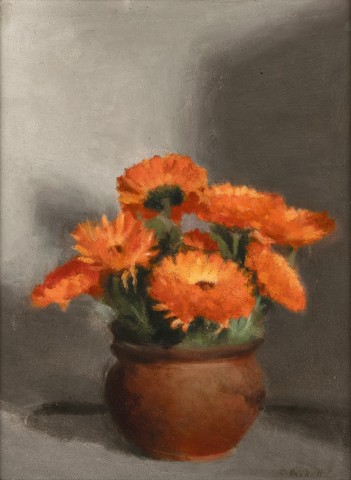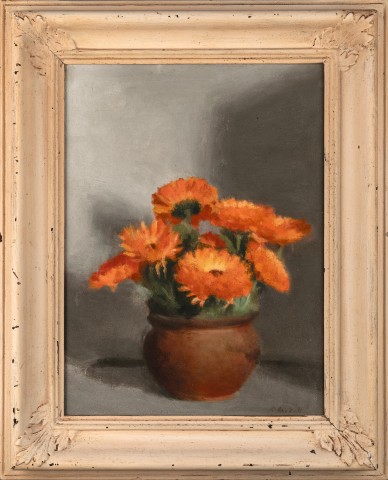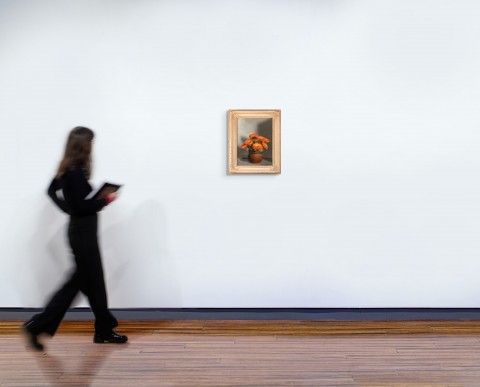MARIGOLDS, c.1925
CLARICE BECKETT
oil on board
40.5 x 30.5 cm
signed lower right: C. Beckett
bears inscription verso: Clarice Becket [sic]/ 10 Guineas
Grace Seymour, Melbourne c.1930s, acquired directly from the artist
Thence by descent
Private collection, Melbourne
Deutscher~Menzies, Melbourne, 21 August 2001, lot 25
Private collection, Sydney, acquired from the above
Still Life (Marigolds), 1925, oil on board, 30.5 x 40.8 cm, in the collection of the Castlemaine Art Gallery and Historical Museum, Victoria, Maud Rowe Bequest 1937
We are grateful to Brenda Martin Thomas, wife of the late David Thomas AM, for kindly allowing us to reproduce David’s writing in this catalogue entry.
Still life subjects are well-suited to the art of Clarice Beckett as stillness was such a fundamental aspect of her painterly aesthetic. In her lifetime, paintings of flowers were notably favoured more than landscapes, and their bright colours always caught the eye of the viewer. Asters, carnations, roses, and petunias were the single and group subjects of numerous still life paintings exhibited in the spring and autumn exhibitions of the Victorian Artists’ Society in East Melbourne during the twenties. Her first solo exhibition in 1923 featured so many flower paintings that the review in the Sun News-Pictorial was headed ‘Vases and Flowers: Miss Beckett’s Art.’
‘Nearly 80 paintings by Miss Clarice Beckett were exhibited yesterday at the Athenaeum. There is one portrait; the rest are land or seascapes, and some effective still life studies. Daisies; and Mr Sherlock's Asters, and a Japanese Vase show the artist at her best… Her work denotes a fine appreciation for natural beauty.’1
In her Memorial Exhibition held in May 1936 at the Athenaeum, Melbourne, flowers also played a significant role, The Wattle being a lone native among the camellias and chrysanthemums. Beckett’s champion, Rosalind Hollinrake, noted that, ‘Unlike her contemporaries Ellis Rowan and Margaret Preston, Beckett did not paint native flowers.’2 She acknowledged one exception, the painting titled Gladioli exhibited at the Victorian Artists’ Society in 1922, to which gum leaves had been added. ‘Her attitude to native flora’, Hollinrake continued, ‘was that the Australian bush was fragile despite its seeming hardiness and that bush flowers should be left where they belong.’3 Significantly, among the works unveiled in her Memorial show was a painting titled Marigolds, with its price of twenty-five guineas indicating that it was considered the best of the group. Some years later, the painting, Marigolds (Still Life), 1925, was bequeathed to the Castlemaine Art Gallery and Historical Museum, Victoria – thus becoming one of the first works by Beckett to enter a public collection. Today the painting remains widely acclaimed among the artist’s finest flower pieces, and is complemented by the slightly larger, Marigolds, c.1925 on offer here. If the Castlemaine version has a lighter setting, with a strikingly simple ground of subtle fawns and greys, the flowers contained in a green glazed Chinese ginger jar, the present work places more focus upon the colour burst of orange flowers – while still maintaining all the subtle interplay of the former. Both provide a tangible sense of the flowers’ presence through an aura of tone and ravishing colour, thus eloquently illustrating that Beckett’s understanding of beauty was not purely confined to landscapes.
1. Sun News-Pictorial, Melbourne, 5 June 1923, p. 9
2. Hollinrake, R., Clarice Beckett: Politically Incorrect, Ian Potter Museum of Art, Melbourne, 1999, p. 16
3. ibid.
DAVID THOMAS


